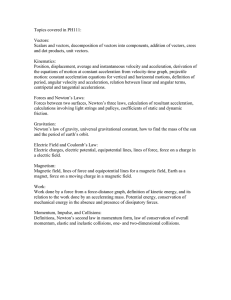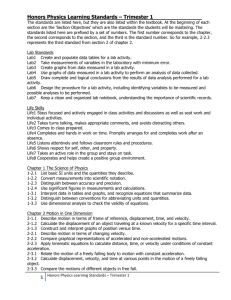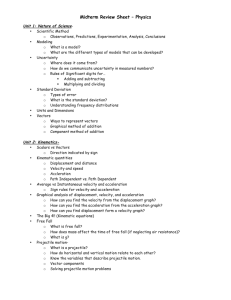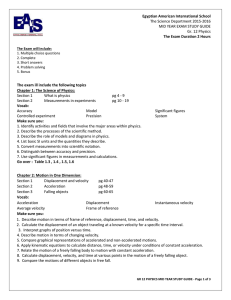First Semester Final Topic Review
advertisement
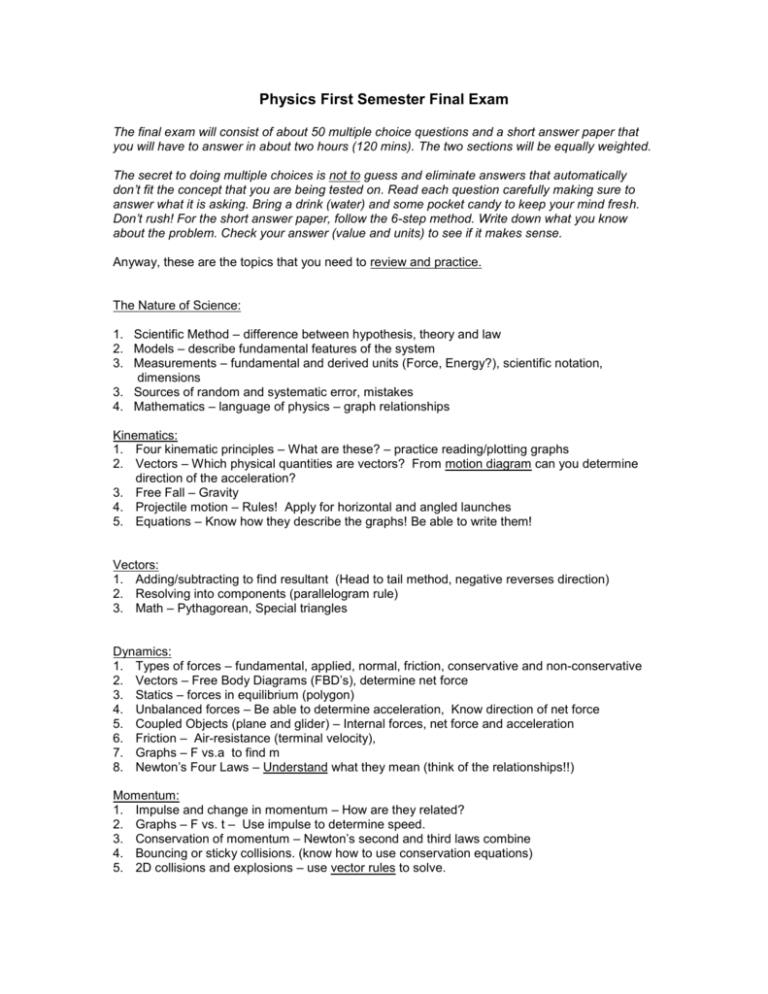
Physics First Semester Final Exam The final exam will consist of about 50 multiple choice questions and a short answer paper that you will have to answer in about two hours (120 mins). The two sections will be equally weighted. The secret to doing multiple choices is not to guess and eliminate answers that automatically don’t fit the concept that you are being tested on. Read each question carefully making sure to answer what it is asking. Bring a drink (water) and some pocket candy to keep your mind fresh. Don’t rush! For the short answer paper, follow the 6-step method. Write down what you know about the problem. Check your answer (value and units) to see if it makes sense. Anyway, these are the topics that you need to review and practice. The Nature of Science: 1. Scientific Method – difference between hypothesis, theory and law 2. Models – describe fundamental features of the system 3. Measurements – fundamental and derived units (Force, Energy?), scientific notation, dimensions 3. Sources of random and systematic error, mistakes 4. Mathematics – language of physics – graph relationships Kinematics: 1. Four kinematic principles – What are these? – practice reading/plotting graphs 2. Vectors – Which physical quantities are vectors? From motion diagram can you determine direction of the acceleration? 3. Free Fall – Gravity 4. Projectile motion – Rules! Apply for horizontal and angled launches 5. Equations – Know how they describe the graphs! Be able to write them! Vectors: 1. Adding/subtracting to find resultant (Head to tail method, negative reverses direction) 2. Resolving into components (parallelogram rule) 3. Math – Pythagorean, Special triangles Dynamics: 1. Types of forces – fundamental, applied, normal, friction, conservative and non-conservative 2. Vectors – Free Body Diagrams (FBD’s), determine net force 3. Statics – forces in equilibrium (polygon) 4. Unbalanced forces – Be able to determine acceleration, Know direction of net force 5. Coupled Objects (plane and glider) – Internal forces, net force and acceleration 6. Friction – Air-resistance (terminal velocity), 7. Graphs – F vs.a to find m 8. Newton’s Four Laws – Understand what they mean (think of the relationships!!) Momentum: 1. Impulse and change in momentum – How are they related? 2. Graphs – F vs. t – Use impulse to determine speed. 3. Conservation of momentum – Newton’s second and third laws combine 4. Bouncing or sticky collisions. (know how to use conservation equations) 5. 2D collisions and explosions – use vector rules to solve. Energy: 1. Work and transfer of energy – How are they related? (Work-energy theorem) 2. Graphs – F vs. d – Use work and kinetic energy to determine speed 3. Types of energy – mechanical and non-mechanical 4. Springs – Hook’s Law, F vs. x graph for spring, spring constant – k (slope) 5. Power – Units: Watts and Horsepower (Know how they are defined) 6. Conservation of Energy – Elastic and inelastic collisions (momentum), roller coaster, spring systems 7. Equations – Make sure you know how to use equations for different types of collisions Circular Motion: 1. Centripetal force and acceleration – Relationship to speed and distance 2. Work on object undergoing circular or elliptical motion (gravity) - satellites 3. Car rounding a bend – friction towards center of turn 4. Gravitational field strength (g) – determine for surface of a planet or point in space General: 1. Be able to recognize graphical relationships – linear, quadratic, inverse, inverse-square 2. Be able to write expressions based on graphical data 3. Be able to rearrange formulas 4. Be able to complete simple unit conversions (km/h – m/s) using scientific notation Doing well in the final isn’t luck. Start today by writing down as a list the fundamental concepts for each of the units listed above. Use your text book and notes to work problems without looking at the answers. Review your tests and labs. How were you asked to generate and analyze data? What were you expected to learn from these activities? Study efficiently! Take a 5 min break every 20-30 mins. Feel free to have back-ground noise but no distractions. Staring at your notes for two hours isn’t studying physics. Mr. Fawcett Thermal: (NOT ON THE EXAM THIS YEAR!) 1. Difference between temperature, heat, internal energy 2. Calculate heat, specific heat capacity, 3. Understand mechanism of heat transfer – conduction, convection and radiation 4. Phase Changes – Explain cooling and heating processes by referring to molecular motion 5. Calculate heat transfer involving a phase change

